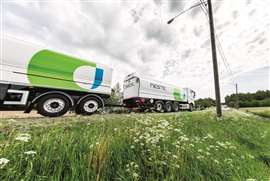Power Progress Newsmaker of the Year for 2023 is...
30 November 2023
Alternative fuels could be the savior of the ICE, but which will dominate?
When it comes to reducing engine emissions, the consensus is that it’s not a problem with internal combustion but with the fuel used in an internal combustion engine (ICE). Following on from that, 2023 has been the year to assess which of the alternative low- and zero-carbon fuels might have a long-term future in the off-highway and commercial vehicle markets.
The alternative fuel roll call features a series of potential candidates, including liquid biofuels (biomethanol, etc.), gaseous products (biomethane, etc.) and even hydrogen. But the fuel type that appears to have garnered the most attention is hydrotreated vegetable oil, or HVO – sometimes referred to as green or renewable diesel.
Engine OEM Cummins describes HVO as “a diesel-like fuel that can be produced without fossil resources by processing renewable waste lipids.” The resulting paraffinic fuel does release CO2 when burned but achieves an overall 90% emission reduction due to the base product biomass having already absorbed a proportional percentage of carbon dioxide from the atmosphere. The fuel also produces lower NOx and particulate levels as it has no aromatics, which increase smoke levels.
 Neste is currently Europe’s leading producer of HVO. (Photo: Neste)
Neste is currently Europe’s leading producer of HVO. (Photo: Neste)
Meeting EN 15940 standards and Fuel Quality Directive 2009/30/EC, it’s a drop-in replacement for diesel that through sourcing, production and end use creates its own circular economy. This is particularly accurate when the fuel is used in cultivation of crops where wastage – not food products – can be used to produce raw oils.
As far back as 2008, Neste Oils and SAE International released a white paper comparing the performance of pure HVO, a 30% HVO/70% diesel blend and EN 590 sulphur-free diesel fuel. The conclusion was that, using default injection timings, the 100% HVO fuel delivered a 6% lower NOx output and 35% less smoke (read: particulates) compared to diesel alone.
According to UK fuel supplier Crown Oil, HVO is available at a premium over mineral-based fuel, but that higher cost is offset (to some degree) by not needing to update engines to benefit from the product.
Crown added that HVO offers a range of other advantages. For example, HVO remains “mobile and filterable” at low temperatures, while meeting or exceeding the lubricity requirements of the major diesel performance specifications (EN 590 and ASTM D975). Further, with good tank maintenance and storage conditions, HVO can be bunkered for up to 10 years, where mineral diesel should only be stored for one year.
OEM approval
HVO is continuing to make waves across the diesel engine market. In March this year, Cummins announced it had approved HVO for its Off Highway Performance Series engines.
“HVO is a low-carbon solution that enables customers to reduce their greenhouse gas emissions while using their current equipment,” said Jeremy Harsin, Cummins Off Highway marketing director. “It can be supplied through the same infrastructure as conventional diesel, making it easy to use.”
 Meros Yachtsharing has tested HVO with their Rolls-Royce powered Sunseeker Blue Infinity One. (Photo: Rolls-Royce)
Meros Yachtsharing has tested HVO with their Rolls-Royce powered Sunseeker Blue Infinity One. (Photo: Rolls-Royce)
Harsin added, “We understand that customers are looking to find ways to improve the sustainability of their businesses. Using equipment installed with our latest ultra-clean and efficient Performance Series engines powered by renewable fuel is a simple and cost-effective step.”
In September, Rolls-Royce added its approval of EN 15940 fuels with the 2000 and 4000 mtu marine engines. The regulation covers BtL (biomass to liquid), PtL (power to liquid) and HVO.
Speaking about the move, Denise Kurtulus, vice president, Global Marine, Rolls-Royce Power Systems, said, “We currently see renewable diesel (HVO) as a very valuable sustainable solution because the fuel is already available and offers some benefits to our yacht customers.
“When running our mtu yacht engines on HVO, which are already benchmarks in terms of exhaust emissions, yacht owners benefit from a significantly reduced carbon footprint while continuing to enjoy best-in-class performance and experience quiet operation with further reduced soot emissions,” she added.
Building confidence
The above is all good news for HVO. But there are some downsides, not least customer acceptance of a relatively unknown product.
 Komatsu is filling machines with HVO prior to customer delivery. (Photo: Komatsu)
Komatsu is filling machines with HVO prior to customer delivery. (Photo: Komatsu)
In May, Komatsu announced it had started filling new machines rolling off the production line with HVO. A Komatsu spokesperson commented: “We have already approved using HVO in 2019 but customers are still concerned about switching to HVO. We would like to send a message to them that we are fully approving the use of HVO and encourage customers to make a switch.”
While a single tank of HVO is not going to save the planet, the move was intended to act as a confidence-boosting measure for customers.
The Japanese machine OEM further noted that while HVO availability was dependent on a customer’s location, the company would introduce them to suppliers should they need assistance getting HVO to their sites. For its part, Komatsu is supporting investigation into development of future HVO feedstocks via its forestry business.
But a push in the right direction is not always sufficient. Komatsu’s move to assuage any HVO-related reticence followed a report published by UK-based contractor Balfour Beatty in 2022, which noted there were “serious issues” with HVO that needed to be addressed before it could commit to the fuel. The issues were largely centered on traceability and carbon claims made about HVO. The report noted: ‘At the heart of our concerns is the fact that, at the moment, the supply chains in this area are complex and opaque, with insufficient information provided about the sources, transportation and production methods.”
Moving forward
Bulk production of HVO has been rapidly increasing across Europe. As of 2020, Finnish company Neste was the largest single producer of the fuel, delivering about 1.5 million tonnes per annum. Over the same year, total capacity across the European Union was 3.5 million tonnes. By 2030, it is forecast that annual production of HVO across the EU will reach 10 million tonnes.
Should production be able to meet demand, it’s forecast that HVO usage across Europe could reach 7.0 million tonnes per year – driven in part by suppliers having to meet 13% greenhouse gas reduction targets for renewable energy used by transport by 2030.
U.S. HVO production currently lags Europe, with 2021 estimated production capacity at just over 2.4 million metric tons. However, the International Energy Agency’s (IEA) Renewable Energy Market Update 2021 attributed 85% of HVO capacity additions globally to U.S. policies and forecast global capacity to nearly double over the following two years, with significant expansion of biofuel production capability from waste and residue feedstocks.
The report cited clean fuel standards and policy support in the U.S. as the main drivers of global capacity growth. Specifically, it cited “the renewable fuel standard, California’s low-carbon fuel standard and a biodiesel blender credit that combine to make HVO projects economically attractive.”
While the renewable fuels race isn’t over yet, and time will tell which fuel will ultimately come to dominate the market, if the past year is any indication, there is already a clear leader.




